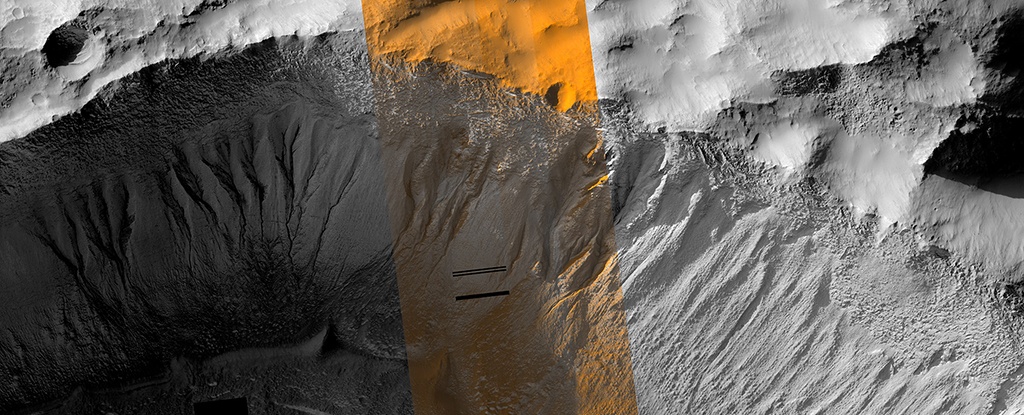Melting Water in Mars Past Could Have Created Martian Gullies
By Laurence Tognetti
A recent study published in Science examines how thin channels inside impact craters on Mars could have formed from Martian gullies, which share similar characteristics with gullies on Earth and are typically formed from cascading meltwater, despite the Martian atmosphere being incapable of supporting liquid water on its surface. However, the researchers hypothesize these gullies could have formed during periods of high obliquity, also known as axial tilt, on Mars, which could have resulted in a brief rise in surface temperatures that could have melted some surface and subsurface ice, leading to meltwater cascading down the sides of impact craters across the planet.
A planet’s axial tilt plays a primary role in determining the climate. For Earth, its axial tilt undergoes a stable precession between 22.1 degrees and 24.5 degrees every 41,000 years due to the gravitational stability from our Moon. As a result, our climate and seasons are relatively stable. However, the planet Mars experiences much more severe axial tilt variances over the course of hundreds of thousands to millions of years, resulting in equally severe changes in climate and seasons, since it doesn’t have a large enough orbiting body to stabilize it. This is because despite Mars having two moons, Phobos and Deimos, they are both much smaller than Earth’s Moon and provide a negligible gravitational tug on the Red Planet.
Currently, the axial tilt of Mars is approximately 25 degrees, but the researchers hypothesize through model simulations and orbiter images that when the axial tilt was at 35 degrees, this resulted in both a rise in atmospheric pressure and summertime surface temperatures across the planet to briefly to allow liquid water to exist. This liquid water could have then cascaded down the sides of impact craters, producing the thin channels we see today, and they say these conditions could have existed as recently as approximately 630,000 years ago.

“We know from a lot of our research and other people’s research that early on in Mars history, there was running water on the surface with valley networks and lakes,” said Dr. Jim Head, who is a professor of geological sciences at Brown University and a co-author on the study. “But about 3 billion years ago, all of that liquid water was lost, and Mars became what we call a hyper-arid or polar desert. We show here that even after that and in the recent past, when Mars’ axis tilts to 35 degrees, it heats up sufficiently to melt snow and ice, bringing liquid water back until temperatures drop and it freezes again.”
The formation of impact crater gullies has been debated in the scientific community for several years, with previous studies suggesting they were formed from carbon dioxide frost sublimation (evaporation) from the Martian regolith, which free up rocks and rubble that slide down impact crater slopes, producing the thin channels. This most recent study not only challenges those previous hypotheses but attempts to paint an entirely new picture for how these impact crater channels form in the first place.
“Our study shows that the global distribution of gullies is better explained by liquid water over the last million years,” said Dr. Jay Dickson, a former researcher at Brown who is now at the California Institute of Technology, and lead author of the study. “Water explains the elevation distribution of gullies in ways that CO2 cannot. This means that Mars has been able to create liquid water in enough volume to erode channels within the last million years, which is very recent on the scale of Mars geologic history.”

As seen on Earth, liquid water leads to life. Therefore, this study raises new hypotheses as to whether life could exist on Mars, either in the present or the past, and the researchers note that axial tilt of Mars will eventually go back to 35 degrees. Additionally, the study also raises awareness for future targets of exploration on the Red Planet, either with robots or humans. There are currently 4,861 separate gully formations identified across Mars, which include craters, valleys, and mounds, totaling tens of thousands of individual gullies that could be explored on future missions.
What new discoveries will researchers make about gullies on Mars, and could liquid water exist on the surface during periods of high axial tilt? Only time will tell, and this is why we science!
As always, keep doing science & keep looking up!
The post Melting Water in Mars’ Past Could Have Created Martian Gullies appeared first on Universe Today.

July 1, 2023 at 07:52AM
via Universe Today read more...

Post a Comment